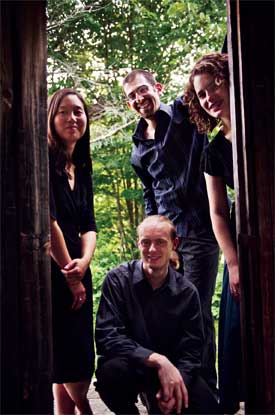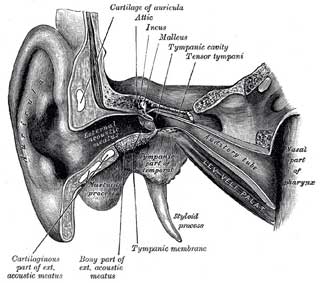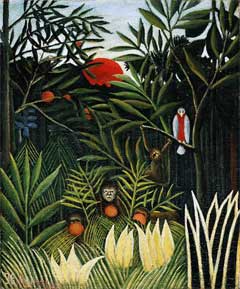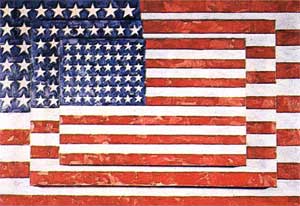Concert
Paine Hall, Harvard University
Cambridge, MA
The Chiara Quartet
Rebecca Fischer, violin
Hyeyung Julie Yoon, violin
Jonah Sirota, viola
Gregory Beaver, cello
Quartet in C Major, K. 465 (1785)
Witold Lutosławski
String Quartet (1964)
Antonin Dvořák
Quartet in F Major, Op. 96 (1893) “American”

Clockwise from left:
Hyeyung Julie Yoon (2nd violin)
Jonah Sirota (viola)
Rebecca Fischer (1st violin)
Gregory Beaver (cello)
Photo: Liz Linder
It was a pleasure to get to hear The Chiara Quartet twice in succession, first in a noontime preview and then in the full program the following evening. Both were wonderful performances and a great couple of tastes of this adept, expressive and youthful quartet that has been in residence at Harvard for several years.
They play with assurance, precision and verve. I was struck by the commanding top and bottom voices of Rebecca Fischer on first violin and Gregory Beaver on cello. But, Hyeyung Julie Yoon’s irrepressible enthusiasm on second violin and Jonah Sirota’s more sedate intermediate interfacing on viola readily became evident.
The intentional combination of formality and informality in the musical approach was made emblematic by the subtle modulation in dress by the two male members of the quartet, each of whom, in alternation, wore a tie, or not, during each of the performances I heard.
Overall, the effect was precision, with exuberance and a kind of youthful abandon that was refreshing and invigorating.
Quartet in C Major, K. 465 (1785) “Dissonance” by W.A. Mozart
Did He Really Mean That?

According to the program notes, a lot of people thought that Mozart could not have intended the opening to this quartet because it sounds so off key. Apparently, even Haydn had his doubts, but he finally came to say: “Well, if Mozart wrote it, he must have meant it.” Indeed, with, and because of, its tonal oddities, it has become one of the pillars of the string quartet literature.
The opening movement began with a plaintive violin line, followed by a beautifully interleaved cello in give and take, creating a lovely amalgamated melange that was animated and energetic. The Andante featured a love duet, again between first violin and cello in call and response, as though they were talking, and supported by an echo in the second violin near the end. The Menuetto and Allegro brought forth a wonderful questioning from the cello. Though extremely competent and specific, I looked a bit more to Rebecca Fischer’s violin for a little more gypsy abandon in the response. The last movement demonstrated fabulous intricate runs in the first violin. Again, there was a pronounced call and response between cello and the first violin, with a fabulous wending of variations returning to a pleasant and quiet home.
String Quartet (1964) by Witold Lutosławski
A Forest of Sound Effects

“Landscape with Monkeys” (1910)
Courtesy Barnes Foundation
Though this quartet has some of its notes written out, some of its music is given by direction, allowing the quartet, each time, to improvise on those.
The introductory movement was a great salad of various sound effects, all inventive and dramatically varied. There were scrapings, cooings, harmonies of various sorts, all beautifully varied. I was struck by the inventiveness of the composition and the competence of this quartet in rendering all of these distinctive sounds. In the second movement, the sense of atmospheric exploration prevailed, again with all members of the quartet exhibiting great assurance in this totally new soundscape. And, here especially, Jonah Sirota’s viola really felt like in came into its own.
Quartet in F Major, Op. 96 (1893) “American” by Antonin Dvořák
American Folk Songs in an Eastern European Stew

This delightful piece is full of the hints of American folk music and gives a wonderful sense of how this Eastern European composer heard and amalgamated those into his own idiomatic form.
The opening Allegro featured very rich and lyrical viola passages and a beautiful, singing cello solo, followed by an energetic climax. The Lento brought out the singing cello once again, and gripping harmonies. I wanted a bit more of that singing lyricism from the first violin, and was answered with a wonderfully vocalized duet. I was struck by the interplay of the two kinetic and energetic violinists going at it, and by the plaintive charm of the cello, while rendering these Eastern European overtones in a minor key. The Vivace opened with the feeling of a country hoe down, then broke into a minor key exploration, finally ending sweetly and delicately in a gentle recapitulation. The Finale was like a sleigh ride, with the quartet exhibiting strong support for the romp as led enthusiastically by Fischer on first violin. The singing and longing cello solo was followed by great gusto and force in the transitional section. I was taken with the robustness of the viola solo passages near the end.
All contributed to a lovely and vital performance from a wonderfully melded group of young musicians.
– BADMan
Leave a Reply